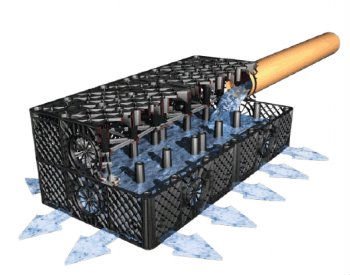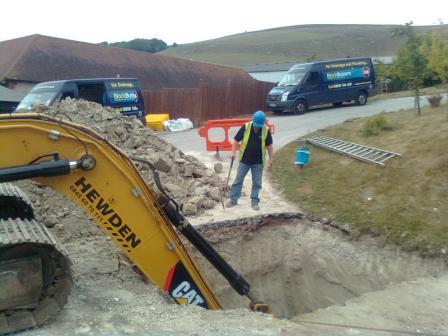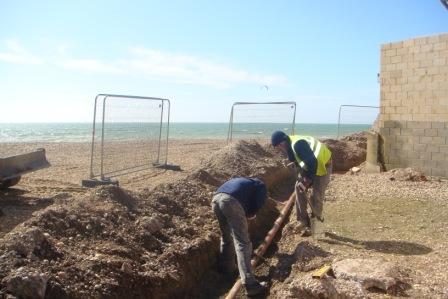
A soakaway consists of a hole dug in the ground and filled with rubble or plastic crates. It provides a solution to excess surface water by letting it slowly drain and soak into the ground instead of build up.
As of 2015, soakaways are no longer an acceptable method of discharging foul water or wastewater as laws governing the discharge of sewage to the ground were changed. Drainage fields now must be used instead, which need a permit from the Environment Agency. A drainage field, also referred to as a septic tank soakaway, will always be connected to a sewage treatment plant or septic tank.
It’s important that you comply with regulations set by the Government’s Environment Agency and don’t build a soakaway as a drainage field or for wastewater effluent disposal. Any soakaway that you build yourself in your garden is purely to allow surface water to percolate through the soil and reduce the risk of flooding.
Read on below for more information about how a rainwater soakaway works, what the benefits of installing one are, and how to make one yourself.
What is a Soakaway Used For?
A soakaway is mainly a useful method of controlling surface water drainage and preventing surplus water from getting into your sewer system and overwhelming it. Not only this, but a soakaway also has other handy uses:
- They mitigate flooding risks during heavy rainfall, helping to prevent resultant damage to the foundations of properties
- They can be used as a way of keeping the ground moist
- They are also a method of keeping a stable water source for gardens
How Does a Soakaway Work?
A rainwater soakaway will be made from soakaway crates that bear a resemblance to old-fashioned milk crates. Soakaways are essentially made by digging a pit in the ground and placing these crates in the hole then connecting the pit to guttering from your property. The crates will be wrapped in a permeable material that lets water through but not debris, thus allowing excess rainwater water to gradually release back into the ground through infiltration.
The Many Benefits of Soakaways:
- Low maintenance requirements
- Can be installed retrospectively
- Cost-effective way of taking surface water away from sewer drains
- Lessen the risks of waterborne diseases
- Simple to install yourself
How to Make a Rainwater Soakaway

While installing a soakaway is a relatively easy process to undertake, you should perform a percolation test before making one so that you can ensure the water will actually be able to seep into the soil. If the ground is unsuitable, like clay soils are, localised flooding can occur due to waterlogging.
How to Carry Out a Percolation Test:
- Make sure you choose a day with no rain
- Dig a hole in your garden around 30cm square
- Fill this hole completely with water
- Leave the water-filled hole for around 4 hours
- If, when you come back to the hole, the water has not drained or has drained very little, your soil is not suitable for a rainwater soakaway
Whenever you’re unsure about best practices for drainage systems or what is right for your property, it’s best to get the professionals in. At BlockBusters, we’re committed to no-strings-attached, excellent customer service and are always on hand to give expert advice. Just call one of our highly-trained professionals on 0800 084 6709.
A Step-By-Step Guide to Making a Rainwater Soakaway

Materials you’ll need, which can be found easily online or in-store at any dedicated DIY supplier:
- Shovel
- Measuring implement
- Soakaway crates
- Geotextile membrane (large sheets of fabric used in ground engineering that water can soak through but won’t let other debris get through)
- Strong tape
- Utility knife, like a Stanley knife
- Drainpiping
- Compacted sand or shingle
Once you’ve carried out a successful percolation test and are confident you’re complying with local building and planning regulations, you can start making your rainwater soakaway.
- Choose a spot to dig your pit
Choose a spot on soft turf at a lower area in your garden, 5m away from the walls of any buildings on or around your property and 2.5m away from your property boundary.
- Dig your pit
The pit needs to be large enough for the soakaway crate you have to fit in as well as spaces for a base, backfill, and side fill, so use your crate as a measurement guide. Make sure you’ve removed any stones or tree roots and smooth out the bottom of the pit after you’ve finished digging.
- Dig a drainpipe trench
Dig a trench that runs from your rainwater pipes on the side of your house to the soakaway pit.
- Fill your pit
Fill the bottom of your pit with about 15cm of compacted sand or shingle. Wrap your soakaway crate in the geotextile membrane, making sure the membrane covers any outward-facing surfaces, including the pipe entry point.
- Fit the pipe
Locate the pipe entry point that you just covered with membrane, mark the middle of it, and use a Stanley knife to cut a cross into it. Insert the drainpipe through this, ensuring to push it in up to 15cm.
- Backfill the pit
Now fill up the sides of your pit with your sand or shingle to about 15cm, which will hold the pipe in place, then cover the top of the crates entirely with 15cm more of the sand or single. Then, cover the rest with ordinary soil and the turf you previously dug up and the job is done.
Soakaway Maintenance
Soakaways shouldn’t be just left completely, you should check that it’s kept clear of vegetation in the surrounding soil so roots don’t interfere with drainage. The average rate for soakaway renewal is about once every decade, depending on the individual conditions.
If you’re looking to install a new drainage field soakaway or septic tank because yours is experiencing a blockage and not working properly, please get in contact with BlockBusters as this is a job for professionals. Your entire treatment system may need replacing and it’s important you get it right.
Expert Drainage Advice From Professional Drainage Engineers
Whatever your drainage requirements are, we are always happy to discuss your needs and offer free, impartial advice. If you need someone to look over your drainage systems and give on-site advice about soakaways, book in a free drain inspection with us today and we can identify any professional work that needs doing with no-obligation quotes.
Contact the team